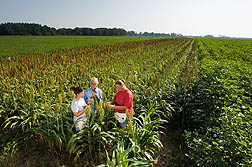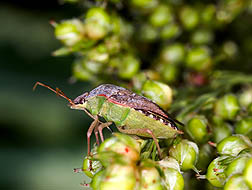Defending Against Two Cotton Pests—Naturally
Cotton growers used to be bedeviled by boll weevils. Now, thanks to a successful large-area eradication program, the weevils are no longer a problem in most U.S. cotton fields.
But stink bugs have filled the void boll weevils left in parts of the Southeast. Stink bug infestations cost Georgia farmers about 3 percent of their cotton in 2003.
Entomologist Patricia Glynn Tillman in ARS’s Crop Protection and Management Research Unit at Tifton, Georgia, and entomologist Ted Cottrell in ARS’s Fruit and Nut Research Laboratory at Byron, Georgia, are exploring use of trap crops in combination with pheromone traps to control two troublesome members of the family Pentatomidae: brown stink bugs (Euschistus servus) and southern green stink bugs (Nezara viridula). Trap crops are small plots specially planted to attract various pests away from cash crops or to concentrate the pests in a small area for more efficient disposal.
During 5 years of study, the researchers conducted on-farm tests to determine the usefulness of combining a sorghum trap crop with pheromone-baited capture traps to keep stink bugs out of cotton.
Peanut-cotton and corn-cotton farming configurations, or “farmscapes,” are common in the Southeast. Stink bugs appear to prefer corn and peanuts but will move to adjacent cotton fields when their food supply runs low. However, the pests are ravenous for sorghum!
|
|
So, Tillman and colleagues planted sorghum in a strip along the entire length of a peanut-cotton interface. Pheromone-baited capture traps were placed about 45 to 50 feet apart in various rows. The researchers found that the E. servus population was significantly lower in cottonfields that had the two management strategies than in cottonfields without them.
In studies of N. viridula populations in a corn-cotton farmscape, the researchers planted a trap crop of sorghum at the interface of the two crops. The density of N. viridula was lower (0.12 bug per 6-foot row) in cottonfields with the sorghum trap crop than in cottonfields without it (1.16 bugs per 6-foot row).
“We proved that sorghum could also serve as a trap crop for N. viridula adults in a corn-cotton farmscape,” says Tillman. “And by dispensing traps baited with the aggregation pheromone for Euschistus species, we were also able to capture E. servus in the field and control their populations in cotton.
“We got a two-part action,” Tillman says. “The sorghum attracted E. servus and N. viridula, and the pheromone-baited traps captured the Euschistus as well as some N. viridula.”
As an added benefit, the sorghum served as a refuge for stink bugs’ natural insect enemies, such as the tachnid fly Trichopoda pennipes, further helping to protect the cotton plants.
“These encouraging results demonstrate that biologically intensive practices can be effective in controlling stink bugs and can assist farmers in providing quality crops to consumers,” says Tillman.—By Sharon Durham, Agricultural Research Service Information Staff.
This research is part of Crop Protection and Quarantine, an ARS national program (#304) described on the World Wide Web at www.nps.ars.usda.gov.
Patricia Glynn Tillman is in the USDA-ARS Crop Protection and Management Research Unit, 2747 Davis Rd., Tifton, GA; phone (229) 387-2375, fax (229) 387-2321.
"Defending Against Two Cotton Pests—Naturally" was published in the January 2008 issue of Agricultural Research magazine.








